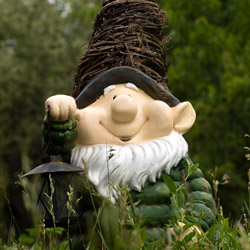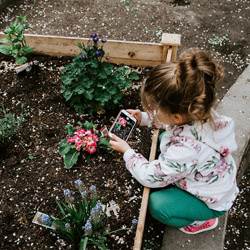Gardening is a valuable skill and teaching young children to garden imparts to them much more than just how to grow plants. Raising the next generation of gardeners is incredibly rewarding and adapting gardening practices to engage kids will get children of all ages enthusiastic about soil, seeds, and harvests.
What Gardening Teaches Kids
Gardening is a valuable skill for children to learn, and it involves much more than just the everyday language of gardening, how to use garden tools, or learning about produce. Gardening can teach children…
- The value of commitment and following through on a long-term task to complete a goal
- Patience while waiting for plants to mature and produce
- Hand-eye coordination and refined motor skills to manipulate tools and seeds
- Planning and organization to create a garden and master the tasks for it to flourish
- The science of water cycles, ecosystems, weather, climate change, ecology, insects, and more
- Cooperation and how to work with others to manage and tend a larger garden
- Healthier eating habits and a better knowledge of how food gets to the table
- Confidence and a sense of accomplishment with a well-grown, productive garden
With so many skills connected to gardening, teaching children to garden can enhance many areas of their well-being and give them skills that can be used throughout their lives.
How to Engage Kids in Gardening
The key to encouraging children to garden from an early age is to adapt gardening to their skills and interests. Fortunately, there are many ways to plant the seeds of gardening interest in young minds.
- Start at the Beginning
Children should be involved in all aspects of gardening from the very start of the process. Allowing children to help choose where a garden should be located and which plants ought to be grown will help them feel invested in the project, and that ownership will help them be more willing to see it through. Let children browse seed catalogs to choose what interests them or bring them to the garden center to shop for seeds, seedlings, new tools, and garden accessories they can be excited about. - Keep It Small
A large, complex garden can be overwhelming to a young gardener. A smaller plot, however, such as a single row, a dedicated flowerbed, a raised bed, or even just one container can become their very own garden and personal gardening space. This will let them tackle gardening tasks on a more comfortable scale that they can manage. A smaller space will also be more practical for young gardeners to ensure they don’t lose interest with repetitive tasks. - Choose Kid-Friendly Plants
Allowing youngsters to choose their own plants is a great way to encourage their gardening interest and kid-friendly plants such as watermelons, pumpkins, carrots, and sunflowers are all fantastic choices. Let young gardeners select flowers in their favorite colors or foods they are already familiar with to engage their interest and keep them looking forward to each new development in the garden. - Incorporate All Senses
A child will expect that a garden will eventually be tasty, but incorporating all their senses throughout the garden will excite them even more. Choose fragrant herbs and flowers to complement different parts of the garden, foliage that may make unusual sounds in a breeze, and plants with different touchable textures, shapes, and colors to add variety to the space. While it is important to avoid plants that could be dangerously toxic or might have sharp thorns, a varied garden will be one children will find more interesting. - Provide Proper Tools
Most garden tools aren’t sized for tiny hands and may be awkward for younger gardeners to hold and manage. Instead, opt for specially sized tools designed for kids, which will have smaller handles and easier grips. Tools in fun colors or bright patterns can also keep kids excited about gardening, and having their own bucket or basket of tools will ensure young gardeners are fully vested in all the activities of gardening. And don’t forget child-sized gardening gloves and an appropriate garden hat for sun protection as well! - Add Fun in the Garden
Make the garden a fun place for kids to be by adding extra touches such as a quirky garden gnome, themed garden flags, or energetic pinwheels. These simple decorations can help kids make the space their own and bring extra color and activity to the garden. Making personalized plant tags, steppingstones, row markers, or other garden accessories can be fun craft projects that help kids feel empowered in the garden space and will teach them about additional garden tasks and why they are important. - Share With Friends
Turn gardening into a play date by inviting friends to help with outdoor tasks, such as weeding, planting, watering, mulching, and more. Turning the task into fun will not only encourage children to complete garden chores but may also inspire more children to take up gardening. Other ways to share gardening with the next generation include introducing a children’s garden or gardening group to a local church, school, or community center. - Go Beyond the Garden
Reinforce gardening lessons by moving beyond the garden. Involve children with cooking the produce they raise, including making jams, jellies, salsas, pickles, and preserves, and remind children that they contributed to these delicious treats whenever you enjoy them. Teach children how to compost spoiled produce and wilted plants, and consider entering their best produce in a county or state fair to recognize their efforts.
The more methods you use to get kids involved in gardening, the more interest they will have and soon they will build life-long gardening habits.





